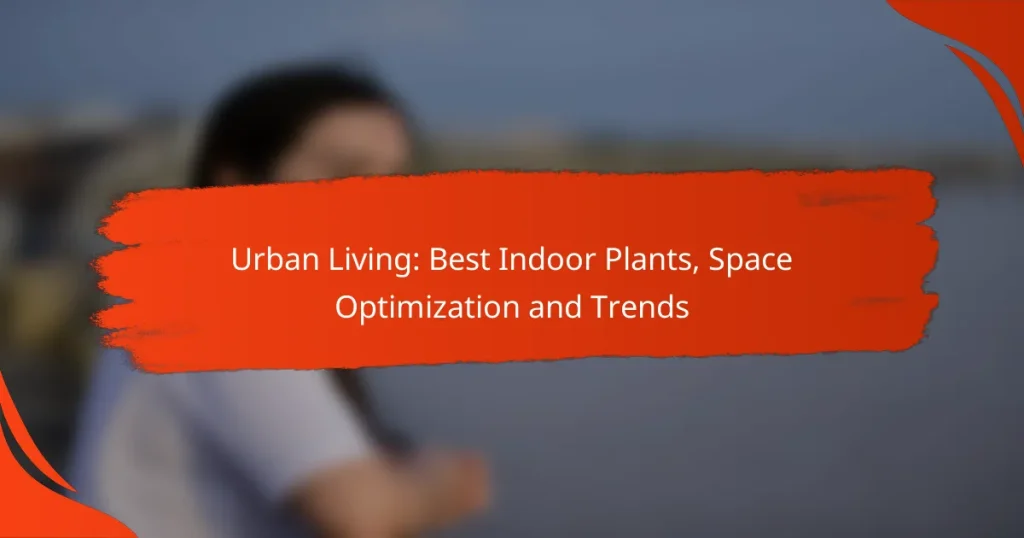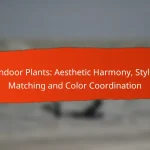Urban living presents unique challenges for incorporating greenery, but the right indoor plants can thrive even in limited light and space. By selecting hardy varieties and utilizing innovative space optimization techniques like vertical gardening and multi-functional furniture, city dwellers can enhance their homes while improving air quality and well-being. Embracing current trends in biophilic design and smart plant care further enriches the indoor experience.
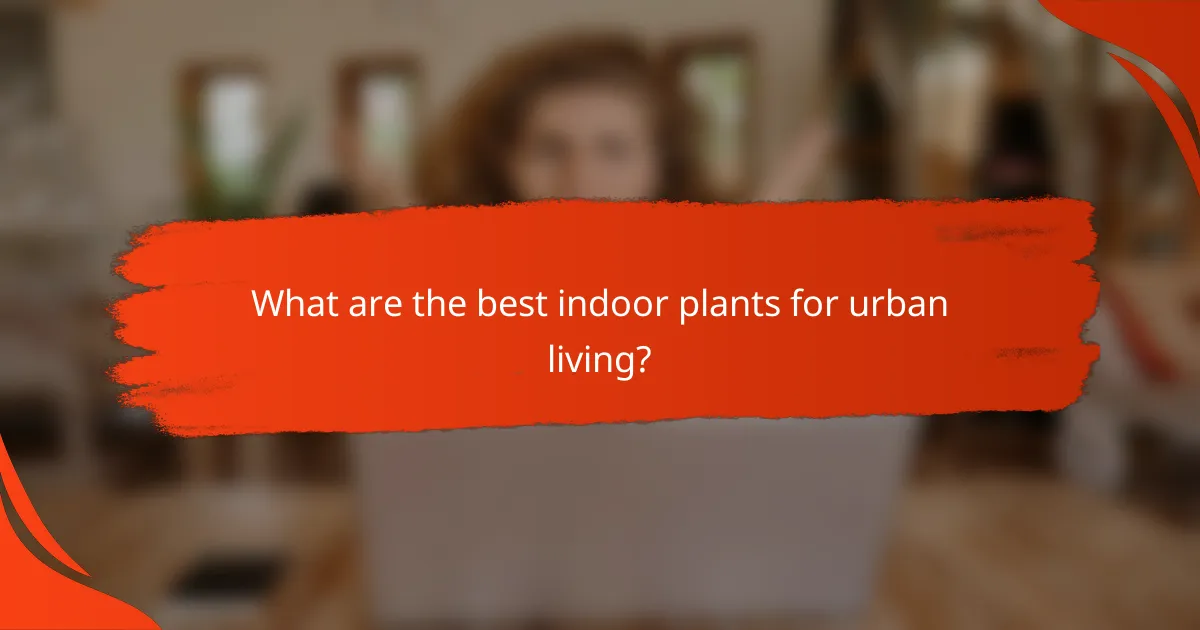
What are the best indoor plants for urban living?
The best indoor plants for urban living are those that thrive in limited light, require minimal maintenance, and improve air quality. Popular choices include hardy varieties that can adapt to various indoor conditions, making them ideal for apartment dwellers.
Snake Plant (Sansevieria)
The Snake Plant is an excellent choice for urban living due to its resilience and low light requirements. It can tolerate neglect, needing water only when the soil is completely dry, making it perfect for busy lifestyles.
This plant also acts as a natural air purifier, removing toxins from the air. Place it in a corner or on a shelf, as it grows upright and doesn’t take up much space.
Pothos (Epipremnum aureum)
Pothos is a versatile and easy-to-care-for plant that thrives in various lighting conditions, from low light to bright indirect sunlight. Its trailing vines can be trained to grow along shelves or hang from pots, adding a touch of greenery to any urban space.
This plant is also known for its air-purifying qualities, making it a great addition to homes. Regular watering every one to two weeks is sufficient, but be cautious of overwatering.
Peace Lily (Spathiphyllum)
The Peace Lily is favored for its beautiful white blooms and ability to thrive in low light. It prefers consistently moist soil, so regular watering is essential, especially in dry indoor environments.
This plant not only enhances aesthetic appeal but also improves indoor air quality by filtering out harmful pollutants. Keep it away from direct sunlight to prevent leaf burn.
Spider Plant (Chlorophytum comosum)
The Spider Plant is known for its air-purifying abilities and adaptability to various indoor conditions. It grows best in bright, indirect light but can tolerate lower light levels.
Regular watering is important, but allow the soil to dry out between waterings. This plant produces “pups” or baby plants that can be easily propagated, making it a fun and rewarding choice for urban gardeners.
ZZ Plant (Zamioculcas zamiifolia)
The ZZ Plant is a hardy option for urban living, thriving in low light and requiring minimal water. Its glossy leaves add a modern touch to any space, and it can survive in neglectful conditions.
Water it only when the soil is dry, as it is susceptible to root rot. This makes the ZZ Plant an ideal choice for those who may forget to care for their plants regularly.
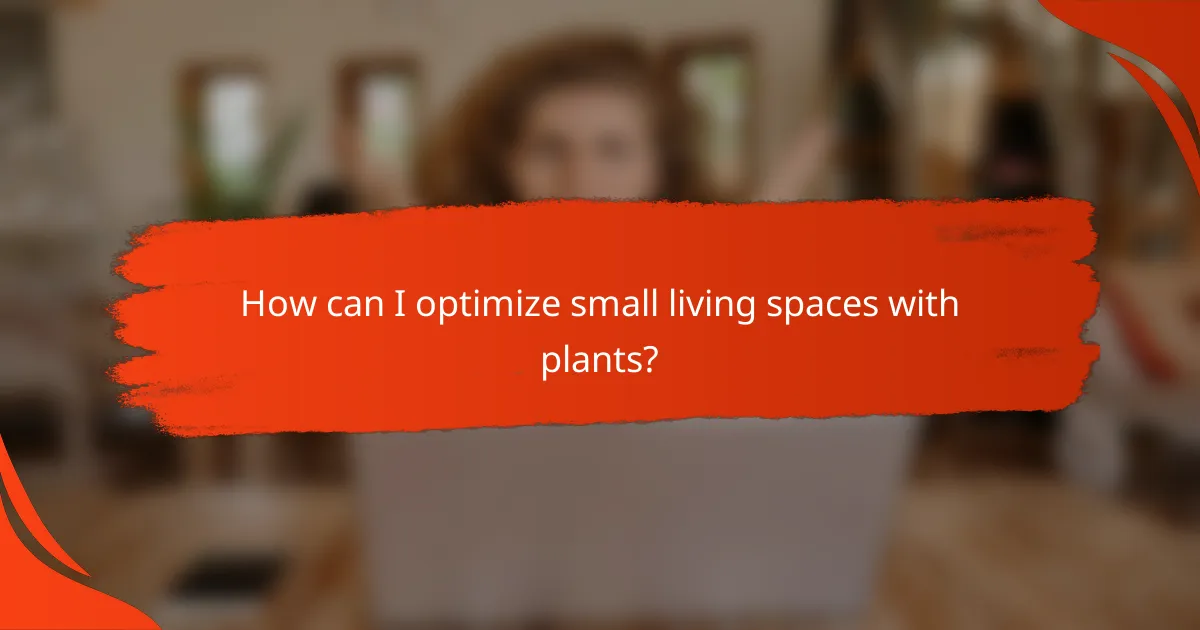
How can I optimize small living spaces with plants?
To optimize small living spaces with plants, consider using vertical gardening, hanging planters, and multi-functional furniture that incorporates greenery. These strategies not only enhance aesthetics but also maximize the use of limited space.
Vertical gardening solutions
Vertical gardening involves growing plants on walls or vertical structures, making it ideal for small spaces. You can use wall-mounted planters, trellises, or even repurpose pallets to create a green wall that adds both beauty and air quality benefits.
When implementing vertical gardens, choose plants that thrive in your local climate and light conditions. Herbs, ferns, and succulents are popular choices that require minimal space and maintenance.
Hanging planters
Hanging planters are an effective way to utilize overhead space while keeping surfaces clear. They can be suspended from ceilings, hooks, or shelves, allowing you to display plants without taking up valuable floor area.
Consider using lightweight materials for hanging planters to reduce strain on fixtures. Opt for trailing plants like pothos or string of pearls, which can create a lush, cascading effect.
Multi-functional furniture with plant integration
Furniture that integrates plants can serve dual purposes, saving space and enhancing decor. Look for coffee tables, bookshelves, or benches that feature built-in planters or designated spaces for pots.
This approach not only provides a stylish focal point but also helps improve indoor air quality. Ensure that the furniture is designed for easy access to plants for watering and maintenance.
Utilizing window sills effectively
Window sills are often underused but can be transformed into mini-gardens. They provide natural light, which is essential for plant growth, making them ideal for herbs, small flowers, or succulents.
When using window sills, choose plants that thrive in direct sunlight and consider using lightweight pots to avoid damage. Regularly rotate plants to ensure even light exposure and prevent leaning.
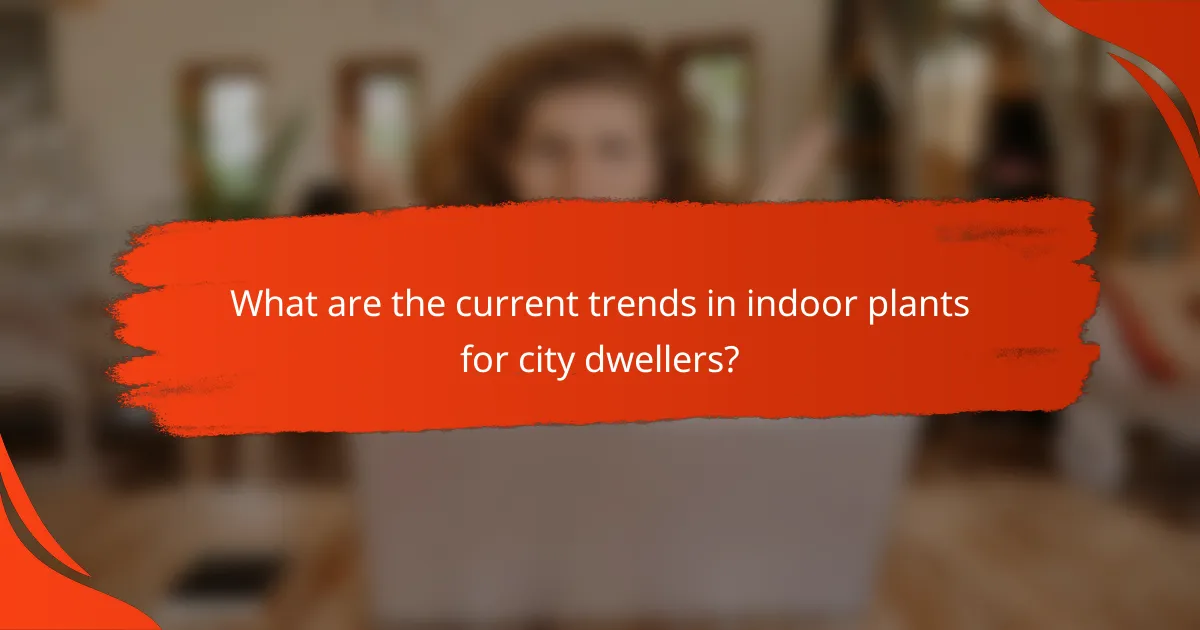
What are the current trends in indoor plants for city dwellers?
City dwellers are increasingly embracing indoor plants as a way to enhance their living spaces, improve air quality, and promote well-being. Current trends focus on incorporating biophilic design, selecting low-maintenance varieties, and utilizing smart technology for plant care.
Biophilic design principles
Biophilic design principles emphasize the connection between nature and indoor environments, making spaces feel more inviting and calming. This trend encourages the use of natural materials, ample greenery, and light to create a harmonious atmosphere. Incorporating plants into urban living spaces not only beautifies them but also supports mental health and productivity.
To implement biophilic design, consider placing larger plants like fiddle leaf figs or rubber plants in prominent areas, while using smaller varieties like pothos or succulents on shelves or desks. The goal is to create a seamless flow between indoor and outdoor elements, enhancing the overall aesthetic and functionality of the space.
Low-maintenance plant varieties
Low-maintenance plant varieties are ideal for busy city dwellers who may not have the time or expertise to care for high-maintenance species. Popular options include snake plants, ZZ plants, and peace lilies, which thrive in various light conditions and require minimal watering. These plants are perfect for beginners or those with hectic lifestyles.
When selecting low-maintenance plants, consider their light requirements and your home’s natural lighting. For instance, snake plants can tolerate low light, while succulents prefer bright, indirect sunlight. This knowledge helps ensure your plants flourish without demanding too much attention.
Smart plant care technology
Smart plant care technology is revolutionizing how urban residents manage their indoor gardens. Devices such as smart pots, moisture sensors, and automated watering systems help monitor plant health and provide care based on specific needs. This technology simplifies plant care, making it more accessible for everyone.
For example, a smart plant monitor can track soil moisture, light levels, and temperature, sending alerts to your smartphone when adjustments are needed. Investing in such technology can enhance your indoor gardening experience, ensuring your plants remain healthy and vibrant with minimal effort.
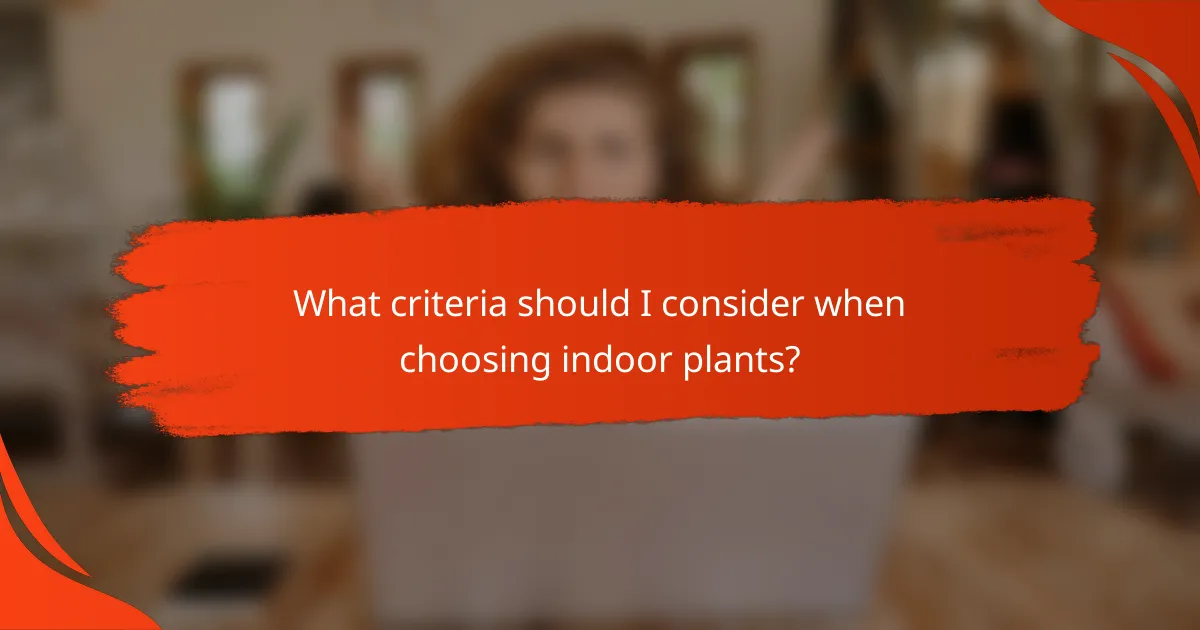
What criteria should I consider when choosing indoor plants?
When selecting indoor plants, consider factors such as light requirements, watering needs, space availability, and potential allergy issues. These criteria will help ensure that your plants thrive in your living environment and complement your lifestyle.
Light requirements
Different indoor plants have varying light needs, which can range from low light to direct sunlight. For instance, snake plants and pothos thrive in low-light conditions, while succulents and cacti prefer bright, direct sunlight. Assess the natural light in your space to choose plants that will flourish in those conditions.
To optimize plant health, place them in areas where they receive the appropriate amount of light. If your space lacks sufficient natural light, consider using grow lights to supplement the needs of light-hungry plants.
Watering needs
Watering requirements vary significantly among indoor plants, with some needing frequent watering and others thriving on minimal moisture. For example, peace lilies may require watering once a week, while succulents can go weeks without water. Understanding each plant’s watering needs is crucial to prevent overwatering or underwatering.
As a general rule, check the top inch of soil; if it feels dry, it’s time to water. Additionally, ensure pots have drainage holes to avoid waterlogging, which can lead to root rot.
Space availability
Consider the amount of space you have for indoor plants, as some species can grow quite large while others remain compact. For smaller apartments, opt for plants like spider plants or small ferns that won’t take up too much room. Conversely, if you have more space, larger plants like fiddle leaf figs can serve as striking focal points.
Utilizing vertical space with shelves or hanging planters can also maximize your indoor gardening potential, allowing you to enjoy a variety of plants without sacrificing floor space.
Allergy considerations
Some indoor plants can trigger allergies or respiratory issues, so it’s essential to choose varieties that are less likely to cause problems. For example, plants like peace lilies and certain ferns are known to be more hypoallergenic compared to others like flowering plants that produce pollen.
If you or someone in your household has allergies, research and select plants that are known for being safe and non-irritating. Additionally, maintaining good air circulation and regularly dusting plant leaves can help minimize allergens in your home.
